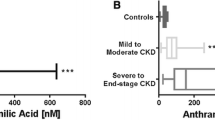Abstract
Thrombin activatable fibrinolysis inhibitor (TAFI) is a glycoprotein, linking coagulation and fibrinolysis. Recently, attention has been drawn to the beneficial effects of statins on haemostasis in kidney patients prone to dyslipidaemia and with a high risk of cardiovascular death. The purpose of this study was to assess whether fluvastatin affects TAFI concentration in renal transplant recipients. We evaluated thrombin–antithrombin (TAT) complexes, prothrombin fragments 1+2, thrombomodulin, plasmin–antiplasmin (PAP) complexes, TAFI, P-selectin, and lipoprotein (a), 1, 2, and 3 months before and after fluvastatin treatment and in normolipaemic kidney transplant recipients and healthy volunteers. Cholesterol and LDL fell significantly as soon as 1 month after treatment had begun and remained lowered during the therapy. TAFI and prothrombin fragments 1+2 decreased significantly after 3 months of fluvastatin administration, whereas P-selectin decreased significantly after 2 months and remained significantly lower after 3 months of this therapy. We can conclude that fluvastatin is an effective hypolipaemic agent that favourably affects haemostasis.
Similar content being viewed by others
References
Locatelli F, Del Vecchio L, Manzoni C (1998) Morbidity and mortality on maintenance hemodialysis. Nephron 80:380–400
US Renal Data System (1999) USRDS 1999 Annual Data Report. National Institute of Health, National Institute of Diabetes and Digestive and Kidney Disease, Bethesda, Md
Pirsch JD, D'Alessandro AM, Solinger HW, Knechtle SJ, Reed A, Klayoglu M, Belzer FO (1992) Hyperlipidemia and transplantation: etiologic factors and therapy. J Am Soc Nephrol 2:238–242
Sweny P, Wheeler DC, Lui SF, Amin NS, Barradas MA, Jeremy JY, Mikhailidis DP, Varghese Z, Fernando ON, Moorhead JF (1989) Dietary fish oil supplements preserve renal function in renal transplant recipients with chronic vascular rejection. Nephrol Dial Transplant 4:1070–1075
Nesheim M, Wang W, Boffa M, Nagashima M, Morser J, Bajzar L (1997) Thrombin, thrombomodulin and TAFI in the molecular link between coagulation and fibrinolysis. Thromb Haemost 78:386–391
Wang W, Boffa MB, Bajzar L, Walker JB, Nesheim ME (1998) A study of the mechanism of inhibition of fibrinolysis by activated thrombin-activatable fibrinolysis inhibitor. J Biol Chem 273:27176–27181
Bajzar L, Nesheim ME, Morser J, Tracy PB (1998) Both cellular and soluble forms of thrombomodulin inhibit fibrinolysis by potentiating the activation of thrombin-activatable fibrinolysis inhibitor. J Biol Chem 273:2793–2798
Ambrosi P, Ailaud MF, Habib G, Kreitman B, Metras D, Luccioni R, Bouvenot G, Juhan-Vague I (2000) Fluvastatin decreases soluble thrombomodulin in cardiac transplant recipients. Thromb Haemost 83:46–48
Malyszko J, Urano T, Knofler R, Taminato A, Yoshimi T, Takada Y, Takada A (1994) Daily variations of platelet aggregation in relation to blood and plasma serotonin in diabetes. Thromb Res 75:569–576
Hryszko T, Malyszko J, Malyszko JS, Brzosko S, Pawlak K, Mysliwiec M (2001) A possible role of thrombin-activatable fibrinolysis inhibitor in disturbances of fibrinolytic system in renal transplant recipients. Nephrol Dial Transplant 16:1692–1696
van Tilburg NH, Rosendaal FR, Bertina RM (2000) Thrombin activatable fibrinolysis inhibitor and the risk for deep vein thrombosis. Blood 95:2855–2859
Malyszko J, Malyszko JS, Pawlak K, Mysliwiec M (1996) Coagulo-lytic system and endothelial function in cyclosporine-treated kidney allograft recipients. Transplantation 62:828–830
Baker LRI, Tucker B, Kovacs IB (1990) Enhanced in vitro hemostasis and reduced thrombolysis in cyclosporine-treated renal transplant recipients. Transplantation 49:905–909
Venrenterghem Y, Roels I, Lerut T, Gruwez J, Michielsen P, Gresele P, Deckmyn H, Colucci M, Arnout J, Vermylen J (1985) Thromboembolic complications and haemostatic changes in cyclosporin-treated cadaver kidney allograft recipients. Lancet:999–1002
Malyszko J, Malyszko JS, Hryszko T, Mysliwiec M (2001) Simvastatin affects TAFI and thrombomodulin in CAPD patients. Thromb Haemost 86:900–901
Agewall S, Wikstrand J, Fagerberg B (1998) Prothrombin fragment 1+2 is a risk factor for myocardial infarction in treated hypertensive men. J Hypertens 16:537–541
Joukhadar C, Klein N, Prinz M, Schrolnberger C, Vukovich T, Woltz M, Schmetter L, Dorner GT (2001) Similar effects of atorvastatin, simvastatin and pravastatin on thrombogenic and inflammatory parameters in patients with hypercholesterolemia. Thromb Haemost 85:47–51
Patrassi GM, Sartori MT, Rigotti P, Di Landro D, Theodoridis P, Fioretti M, Capalbo M, Saggiorato G, Boeri G, Girolami A (1995) Reduced fibrinolytic potential one year after kidney transplantation. Relationship to long-term steroid treatment. Transplantation 59:1416–1420
Ridker PM, Buring JE, Rifai N (2001) Soluble P-selectin and the risk of future cardiovascular events. Circulation 103:491–495
Johnston GI, Bliss GA, Newman PJ, McEver RP (1990) Structure of the human gene encoding granule membrane protein-140, a member of the selectin family of adhesion receptors for leukocytes. J Biol Chem 265:21381–21385
Blann AD, Lip GYH (1997) Hypothesis: is soluble P-selectin a new marker of platelet activation? Atherosclerosis 128:135–138
Aviram M, Hussein O, Rosenblat M, Schlezinger S, Hayek T, Keidar S (1998) Interactions of platelets, macrophages and lipoproteins in hypercholesterolemia: antiatherogenic effects of HMG-CoA reductase inhibitor therapy. J Cardiovasc Pharmacol 31:39–45
Schror K (1990) Platelet reactivity and arachidonic acid metabolism in type II hyperlipoproteinemia and its modification by cholesterol lowering agents. Eicosanoids 3:67–73
Malyszko J, Malyszko JS, Pawlak D, Pawlak K, Buczko W, Mysliwiec M (1996) Platelet aggregation and peripheral serotonergic system in kidney transplant recipients treated with cyclosporin A. Transplant Proc 28:1954–1957
Huhle G, Abletshauser C, Mayer N, Weidinger G, Harenberg J, Heene DL (1999) Reduction of platelet activity markers in type II hypercholesterolemic patients by a HMG-CoA reductase inhibitor. Thromb Res 95:229–234
Goldberg RB, Roth D (1995) A preliminary report of the safety and efficacy of fluvastatin for hypercholesterolemia in renal transplant patients receiving cyclosporine. Am J Cardiol 76:107A–109A
Loscalzo J (1990) Lipoprotein (a). A unique risk factor for atherothrombotic disease. Arteriosclerosis. 10:672–680
Gault MH, Longerich LL, Purchase L, Harnett J, Breckenridge C (1995) Comparison of Lp(a) concentrations and some potential effects in hemodialysis, CAPD, transplantation, and control groups: a review of the literature. Nephron 70:155–165
Author information
Authors and Affiliations
Corresponding author
Additional information
The study was supported in part by a grant from the Polish Research Committee KBN (no. 6 PO 5 8 117 21).
About this article
Cite this article
Malyszko, J., Malyszko, J.S. & Mysliwiec, M. Fluvastin therapy affects TAFI concentration in kidney transplant recipients. Transpl Int 16, 53–57 (2003). https://doi.org/10.1007/s00147-002-0495-9
Received:
Revised:
Accepted:
Published:
Issue Date:
DOI: https://doi.org/10.1007/s00147-002-0495-9




